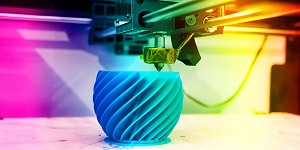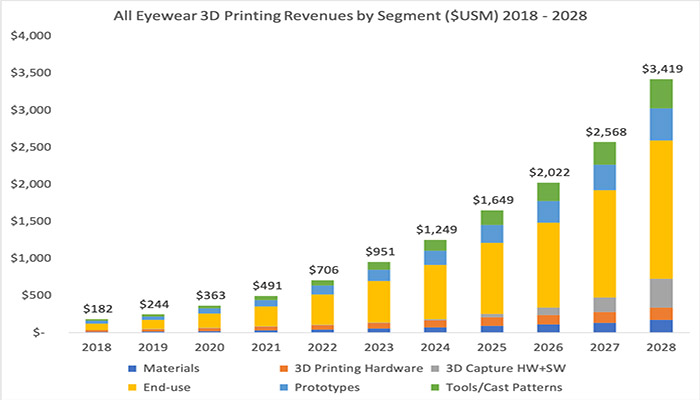
3D Printing 2021

Theme: 3D PRINTING: THE MANUFACTURING TECHNOLOGY THAT WILL CHANGE THE WORLD
International Webinar on 3D Printing will be hosted September 23rd, 2021. Panel of speakers will be delivering their presentations on their recent research related to 3D Printing . Current state of knowledge, its impact on future will be discussed in detailed. Meetings International invites all experts to be part this webinar series and make it a perfect platform for knowledge sharing and networking.
Scientific Session 1: 3d Printing & Additive Manufacturing
Advanced technologies for 3D printing and additive manufacturing and how these technologies have changed the face of direct, digital technologies for rapid production of models, prototypes and patterns. Because of its wide applications, 3D printing and additive manufacturing technology has become a powerful new industrial revolution in the field of manufacturing. The evolution of 3D printing and additive manufacturing technologies has changed design, engineering and manufacturing processes across industries such as consumer products, aerospace, medical devices and automotive. The objective of this book is to help designers, R&D personnel, and practicing engineers understand the state-of-the-art developments in the field of 3D Printing and Additive Manufacturing.
Related Subtracks : 3D Printing and Additive Manufacturing Conference | 3D Printing Materials Symposium | 3D Printing in Industry Workshop | 3D Printing Biomaterials Congress | Polymers in 3D Printing Meeting | Additive Manufacturing and 3D Robotics Seminar | Layer Manufacturing and Additive Fabrication Conferences
Scientific Session 2 : Innovations in 3d Printing
The world of 3D printing has the possibility of creating a newer, better future. From increasing the effectiveness of foreign aid to creating a more sustainable future. The possibilities presented to us by 3D printers have allowed us to imagine a better future. Unfortunately, the majority of objects that can be created are subject to the size of each respective 3D printer. Therefore, we can only print to a minimal extent. Alternatively, 2016 has seen an incredible advancement in the 3D printing sector. Below, we have curated a list of six innovations that will change the future of business and production.
Related Subtracks : 3D Printing and Additive Manufacturing Conference | 3D Printing Materials Symposium | 3D Printing in Industry Workshop | 3D Printing Biomaterials Congress | Polymers in 3D Printing Meeting | Additive Manufacturing and 3D Robotics Seminar | Layer Manufacturing and Additive Fabrication Conferences
Scientific Session 3 : 3d Printing Materials
After over a year of research, countless filament spools, and hundreds of hours of printing, our team is proud to present the Ultimate 3D Printing Materials Guide. Covering over a dozen of the most popular materials in use today, this guide will help you select the best material for your next project or improve the quality of your prints with tips from our experts. Use the tags below to quickly sort the materials based on their characteristics, or view our extensive Filament Properties Table for a detailed side-by-side comparison. Once you have selected a material, view a detailed article with pros and cons, hardware requirements, best practices, pro-tips, example projects and more! Whether you’re new to 3D printing or an advanced user looking to experiment with a new material, this guide has everything you need to make the most of your next project.
Related Subtracks : 3D Printing and Additive Manufacturing Conference | 3D Printing Materials Symposium | 3D Printing in Industry Workshop | 3D Printing Biomaterials Congress | Polymers in 3D Printing Meeting | Additive Manufacturing and 3D Robotics Seminar | Layer Manufacturing and Additive Fabrication Conferences
Scientific Session 4 : Impact of 3d Printing on Industry
The world has seen many intriguing manufacturing technologies so far, however 3D printing has truly grabbed everybody's eye in the course of recent years. Not only does it have the potential to create something through an entirely unique process, but it also has the capability to render some production lines useless. If consumers are able to 3D print their favourite everyday consumer goods using a 3D printer at home, the manufacturing industries will face a serious drawback. On a different note, 3D printing has opened up new opportunities for production, factory maintenance, and R&D, since acquiring spares for a machine has never been easier.
Related Subtracks : 3D Printing and Additive Manufacturing Conference | 3D Printing Materials Symposium | 3D Printing in Industry Workshop | 3D Printing Biomaterials Congress | Polymers in 3D Printing Meeting | Additive Manufacturing and 3D Robotics Seminar | Layer Manufacturing and Additive Fabrication Conferences
Scientific Session 5 : 3d Printing In Biomaterials
3D Printing promises to create complex biomedical gadgets as per PC configuration utilizing patient-specific anatomical data. Since its underlying use as pre-careful representation models and tooling moulds, 3D Printing has gradually developed to make exceptional gadgets, implants, scaffolds for tissue engineering, diagnostic platforms, and drug delivery systems. Before 3D Printing can be used routinely for the regeneration of complex tissues (e.g. bone, cartilage, muscles, vessels, nerves in the craniomaxillofacial complex), and complex organs with intricate 3D microarchitecture (e.g. liver, lymphoid organs), several technological limitations must be addressed. In this audit, the significant materials and innovation propels inside the most recent five years for every one of the regular 3D Printing technologies (Three Dimensional Printing, Fused Deposition Modeling, Selective Laser Sintering, Stereolithography, and 3D Plotting/Direct-Write/Bioprinting) are described.
Related Subtracks : 3D Printing and Additive Manufacturing Conference | 3D Printing Materials Symposium | 3D Printing in Industry Workshop | 3D Printing Biomaterials Congress | Polymers in 3D Printing Meeting | Additive Manufacturing and 3D Robotics Seminar | Layer Manufacturing and Additive Fabrication Conferences
Scientific Session 6 : Additive Manufacturing and 3d Robotics
Additive manufacturing and robotics. One technology relies on steady, repetitive motion to build each infinitesimal layer, over and over again. The other technology is renowned for its repeatability and control. It's as if they were made for each other. It's a match made in disruptive technology, in the future of manufacturing. Robots are not only enabling additive manufacturing, they're tending 3D printing machines (which are also robotic), automating AM post-processing, and allowing architects to envision new, flexible ways to build the world around us. Expanding our possibilities. These technologies are used to develop machines that can substitute for humans and replicate human actions. 3D robots can be used in many situations and for lots of purposes where humans cannot survive robots can take on any form but some are made to resemble humans in appearance in the acceptance of a 3D robot the approach of minimally invasive techniques in robotics, for the advent intervention.
Related Subtracks : 3D Printing and Additive Manufacturing Conference | 3D Printing Materials Symposium | 3D Printing in Industry Workshop | 3D Printing Biomaterials Congress | Polymers in 3D Printing Meeting | Additive Manufacturing and 3D Robotics Seminar | Layer Manufacturing and Additive Fabrication Conferences
Scope and Importance:
The 3D printing market was esteemed at USD 10.58 billion out of 2018, and is relied upon to arrive at an estimation of USD 49.01 billion by 2024, at a CAGR of 29.48% over the forecast period 2019-2024. Toward the finish of 2018, America Makes declared it was granting USD 1.6 million to a joint undertaking between Arizona State University and the ASTM International Additive Manufacturing Center of Excellence. In the prior months of 2019, the project aims to advance post-processing methods for SLM parts.The industry is being constantly driven by technological developments, which guarantee higher adaptability and empower faster design. Further, manufacturers have realized the advantages that 3D printing offers, such as optimizing material, labor, and transportation costs. Manufacturing units have had the option to eliminate material wastage using 3D printing.Governments over the world have just begun putting resources into R&D on 3D printing, which has positively affected on technology propagation and adoption. For example, the Dutch government put an extra USD 150 million in 3D printing-related research and development.However, the market remains constrained by high costs of equipment needed to deploy 3D printing on an industrial scale. The absence of a worldwide principles body directing producers likewise confines the market development.
Source of revenue and analysis of the 3D bio printing market:
With the classification into metals, polymers, ceramic, and bio-ink, the bio printing materials segment accounted for the major shares of the 3D bio printing market. The polymers are broadly utilized in bio printing material that involves both common and synthetic materials. Owing to the favourability of the natural polymers, they are preferred for engineering tissues and organs. Regular polymers involve collagen, chitin, chitosan, hyaluronic corrosive, and chondroitin sulfate. The broad utilization of polymers in bio printing materials will add to the development of the market throughout the following four years.
Market Growth of 3D Printing in the last and upcoming ten years:
3D printing materials have noteworthy development in Middle East locales. Different 3D printing assembling organizations have seen setting-up in the Middle East locales during the most recent couple of years. It's demonstrating that the pattern is probably going to proceed throughout the following 10 years with the accessibility of minimal effort crude materials alongside expanding assembling yield in these areas.Middle East 3D Printing Materials market value is anticipated to expand at a CAGR of 16.7% during the forecast period and along with that the Middle East 3D printing materials market volume is expected to register a CAGR of 11.2% during the forecast period.

Meetings International has organized International Webinar on 3D Printing on April 9,2021. The Theme for the Webinar was 3d Printing: The Manufacturing Technology that Will Change the World. They have conducted Keynote speeches on Additive Manufacturing & 3D Robotics and 3D Printing in Biomaterials, 3D Printing in Automotive Industry and 3D Printing Materials and Methods, Plenary talks on Space & Aerospace 3D Printing and PCBS Electronic Printing and different sessions related to the Webinar. Panel discussions on 3D Fabrication and 3D Printing in Polymers , the latest research developments in the field of 3D Printing .
- 3D Printing & Additive Manufacturing
- Innovations in 3D Printing
- 3D Printing Materials
- Impact of 3D printing on industry
- 3D Printing in Biomaterials
- Journal of Nanomaterials & Molecular Nanotechnology.
- Journal of Fashion Technology & Textile Engineering
- Biomaterials and Medical Applications
2 Renowned Speakers
HAMIDREZA MOSLEH
University of Medical Sciences
Iran
H. YAAGOUBI
Mohammed V University
Morocco






















































































































